Content:
The Russian Trotter is a light-harness category of horses. In modern Russia, the most common type.
History of the creation of the breed
At the beginning of the twentieth century. In the Russian Empire, Oryol trotters and horses of the American breed were in great respect. The breeders decided to cross these two species, although there were many opponents, and the cross breed gave good results. The result is a more playful and fast horse. Since 1928, the breed has been used at racetracks for equestrian sports and in the army (for the movement of military personnel). In 1949, the Russian trotting horse breed was officially registered.
Today it is the most popular breed in Russia. The Russian Trotter horse breed is bred in Moldova, Ukraine, Russia and other CIS countries by hundreds of farms and private breeders. There are reddish-gray, brown, black, dark bay colors.
Brief description of the breed
The horse reaches a height of 165 cm at the withers. It has a strong body constitution, a strong tendon-ligamentous apparatus. The neck is medium, wide forehead. Until now, it is mainly used for equestrian sports or serves as the main one for obtaining new breeds.
In appearance, there is no predominance of clear breed traits. Description of appearance:
- long muscular limbs with a shortened trunk;
- all the signs of draft horses are present;
- expressive dark eyes;
- straight profile;
- slightly elongated ears;
- protruding withers;
- sloping croup;
- long and convex back;
- rounded hooves with elongated horns, capable of withstanding blows of any severity.
How to care for your horse
It is recommended to keep the animal in the stable, which will be ventilated in summer and keep warm in winter. In the summer, do not forget to walk the horse more often, if opportunities allow, to let it graze for the whole day.
The main care is to clean and wash the horse. These horses love to swim, especially in summer, so you can water them directly with a hose. After each walk, it is worth clearing the skin of dirt and sweat, and this should be done in rainy weather, having soaked the horse's pile with a rag. Washing and cleaning your horse will help you find skin wounds and heal them. Particular attention should be paid to hooves that take on a lot of stress.
Feeding features
The nutrition of these horses differs little from the diet of other horses. In summer, during the heat, the horse needs a lot of water (up to 30 liters per day). In winter, the drinker should also be full, but snow will do. The horse's summer diet consists of fresh grass, and the winter diet consists of hay. It is worth feeding the animal with oats, bran. From vegetables, you need to give beets, carrots and cabbage. It is possible to add special additives to the diet, as well as lumps of sugar, which is a treat for horses.
The Trotter is an excellent animal for racing and simple keeping on the farm. He is handsome, friendly even with children and not capricious in his care. It also does not require any special feed, just green grass and hay.













